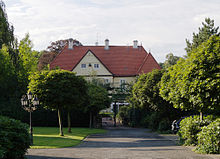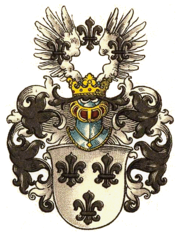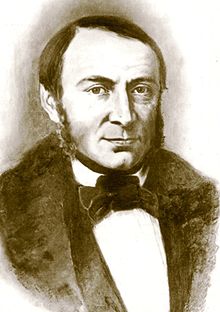Lilies (noble family)
Lilien is the name of an old Westphalian noble family . The family whose branches are in part to this day, one of the Erbsälzern of Werl .
history
origin
The family with the Sälzer zu Werl Dietrich Lilie is mentioned for the first time in a document dated February 5, 1307. The family line begins with Johann Lilien , who died in 1580.


According to Kneschke , the Archbishop of Cologne Konrad von Hochstaden confirmed the family's ownership of the Werl salt works together with their old privileges as early as 1246 .
Possessions and lines
The salt houses were owned by the family until the middle of the 14th century. In 1356, with the golden bull of Emperor Charles IV , they were awarded to the sovereign and belonged to his regalia ( salt shelf ). In 1370 Archbishop Friedrich made them titanable . In 1382, the old privileges were confirmed again by the rulers of the heirs, but in the same year all messages and documents from the families of the heirs were lost during the great fire in Werl. They turned to Emperor Sigismund , who confirmed their old rights with a diploma and testified that they not only came from good, old tribe, but also served the Roman emperors and the holy empire often and in many ways, without sparing property or blood . Several of their ancestors also held considerable civil and military posts.
Johann von Lilien († 1608), the son of the ancestral father of the same name , married Anna von Papen , who also came from an old Werl family of heirs to males. Their son Dietrich von Lilien became mayor of Werl, as was already the Werl councilor and heir alder Hermann Lilie (* before 1453; † 1516) between the years 1499 and 1516. Both of Dietrich von Lilien's sons became the founders of the two main lines of the family.
Johann III. von Lilien, the son of his first marriage to Catharina von Brandis, founded the older Westphalian line. Hermann Franz von Lilien, the son from the second marriage, was the founder of the second younger line.
Gerhard Franz von Lilien († 1726), the son of Johann III, came from the Westphalian main line. von Lilien and Elisabeth von Bendit. The three sons Caspar Hermann, Franz Michael Florentin and Johann Florentin emerged from his marriage to Johanna Clara von Arnsberg. Caspar Hermann von Lilien (* 1691; † 1772) founded the Opherdicke branch in Westphalia with his first wife Maria Franziska von Brandis .
Franz Michael Florenz von Lilien (* 1696, † 1776), was the father of Alexander von Lilien (* 1742), the founder of a branch that later also settled in the Austrian hereditary lands . This branch expired on October 6th, 1846 with the death of Carl Freiherr von Lilien, kk chamberlain and councilor of the court and state chancellery, Herr auf Hohenbruck in Styria . Another branch, founded by Christoph von Lilien (* 1748), son of Franz Michael Florentin, became part of Borg and Laer in Westphalia. Johann Florentin von Lilien (* 1698), the third son of Johann III. von Lilien, was the ancestor of the younger branch of the older main line.
The younger main line founded by Hermann Franz von Lilien (* 1642; † 1706) later also came to Bavaria . Hermann Florentin von Lilien († 1733) came from his marriage to Anna Susanna von Papen. He became a treasurer at Werl and married Johanna Maria von Papen. The descendants of his son Hermann Caspar von Lilien donated the line to Waldau.
Status surveys
Franz Michael von Lilien came from the house of Borg , to Borg and Laer, Erbsälzer zu Werl, princely thurn and taxischer privy councilor and general manager of the posts in the Reich and in the Netherlands , who on December 24, 1756 in Vienna became a baron with the salutation Well born was raised. His son Alexander Freiherr von Lilien, on Sippenau, at first thurn and taxischer Real Privy Councilor and General Postintendant, later royal Bavarian chamberlain , was registered on January 11, 1813 in the baron class of nobility in the Kingdom of Bavaria.
Felix von Lilien , royal Prussian district administrator of the Arnsberg district , came from the Echthausen house and was promoted to the status of Prussian baron in Berlin on October 15, 1840 . The title was awarded in primogenitur and was linked to the possession of the manor Westerhaus-Echthausen. A Prussian expansion of the baron class to include his children (ad person) took place on June 17, 1881 in Ems .
From the house of Opherdicke came Franz von Lilien, to Opherdicke, royal Prussian chamberlain , who received the Prussian baron status in Berlin on July 24, 1854. The title, awarded in primogenitur and from each noble marriage, was linked to the possession of the Opherdicke manor in the Dortmund district ( diploma issued on August 29, 1855 in Sanssouci ). His brother Anton Freiherr von Lilien, kuk Colonel , received on 24 October 1881 Vienna an Austrian authorization to continue a foreign baron title (poster issued on December 7, 1881 Vienna).
Carl von Lilien, auf Waldau and Ilsenbach, royal Bavarian chamberlain, district judge and Kastner zu Beratzhausen came from the Waldau family and was enrolled with his siblings on March 24, 1813 in the aristocratic class in the Kingdom of Bavaria. Siegmund von Lilien, a legal trainee in Munich , was raised to the Bavarian baron status on March 5, 1884 and entered into the baron class of nobility in the Kingdom of Bavaria on June 13, 1884.
coat of arms
Family coat of arms
The family coat of arms shows three (2, 1) black lilies in silver . On the helmet with black and silver helmet covers, a black line between an open, silver flight , each covered with a black lily .
Baron coat of arms
The barons coat of arms by Franz Michael Freiherr von Lilien, awarded in 1756, shows the family coat of arms within a red and silver border and has two helmets. On the right the trunk helmet, on the left with red and silver helmet covers a silver and a red buffalo horn , each covered with a bar in confused colors. A red-winged, golden griffin on the right as a shield holder and a golden lion on the left , both opposing.
All other lines and branches were awarded the family coat of arms during the rankings .
Name bearer
- Alexander Ferdinand von Lilien (* 1742, † 1818), General Director of the Imperial and Dutch Post
- Clemens von Lilien-Borg (* 1776, † 1852), German landowner and politician
- Felix von Lilien (* 1804; † 1886), Prussian civil servant and politician
- Franz Michael Florenz von Lilien (* 1696; † 1776), Thurn-und-Taxis-Hofmarschall and Werler Erbsälzer
- Georg Lilien (also: Lilius; * 1597; † 1666), German Lutheran theologian
- Hermann Lilie (* before 1453; † 1516), Mayor of Werl and Werler Erbsälzer
literature
- Genealogical handbook of the nobility , Adelslexikon Volume VII, Volume 97 of the complete series, CA Starke Verlag , Limburg (Lahn) 1989 ISSN 0435-2408
- Ernst Heinrich Kneschke : New general German nobility lexicon . Volume 5, Friedrich Voigt's Buchhandlung, Leipzig 1864, pages 533-535. ( Digitized version )
- Leopold von Zedlitz-Neukirch : New Prussian Adelslexicon . Volume 3, Reichenbach Brothers, Leipzig 1837, pages 254-255. ( Digitized version )
- Gothaisches genealogical pocket book of the baronial houses for the year 1855. Fifth year, p.344ff
- Gothaisches genealogical pocket book of the baronial houses for the year 1865. Fifteenth year, p.577ff
Web links
- Documents from the Erbsälzerarchiv Werl / digital Westphalian document database (DWUD)
- Coat of arms of those von Lilien in the coat of arms of the Westphalian nobility
- Entry about lilies in Pierer's Universal Lexikon Volume 10. Altenburg 1860, pp. 376–377.
Individual evidence
- ↑ State Archives Münster , Oelinghausen Monastery No. 182
- ^ Genealogisches Handbuch des Adels , Adelslexikon Volume VII, Volume 97 of the complete series, page 370
- ^ A b New General German Adels Lexicon Volume 4, Pages 533-535



